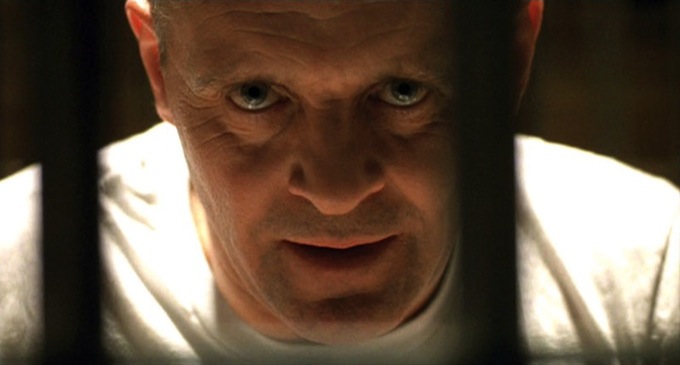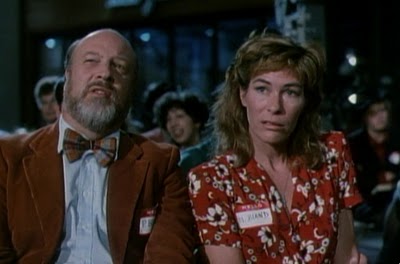 Splatter Cinema and Enjoy the Film present THE SILENCE OF THE LAMBS (1991); Dir. Jonathan Demme; Starring Anthony Hopkins, Jodie Foster and Ted Levine; Saturday, Feb. 21 @ 8:30 p.m.; Cinevision Screening Room; Tickets $10 (cash only); Trailer here.
Splatter Cinema and Enjoy the Film present THE SILENCE OF THE LAMBS (1991); Dir. Jonathan Demme; Starring Anthony Hopkins, Jodie Foster and Ted Levine; Saturday, Feb. 21 @ 8:30 p.m.; Cinevision Screening Room; Tickets $10 (cash only); Trailer here.
By Aleck Bennett
Contributing Writer
Splatter Cinema returns to the Cinevision Screening Room with the help of Enjoy the Film! This time, they’re delivering a 35mm archival print of what is probably the most celebrated mainstream horror film of the 1990s: Jonatham Demme’s staggering THE SILENCE OF THE LAMBS. But don’t be fooled by its widespread appeal. Demme serves up a disturbing dinner of pure horror. With some fava beans and a nice Chianti.
Trivia time: how many horror films have won Academy Awards? Precisely one—Jonathan Demme’s THE SILENCE OF THE LAMBS. Sure, you could make an argument that it’s not really a horror film, but a police procedural or crime thriller. However, if the horror film has taught us anything, it’s that some of its best examples transcend the artificial divisions of genre and the common tropes to be found therein. Michael Reeves’ 1968 masterpiece WITCHFINDER GENERAL, for instance, could be accurately described as simply a period drama depicting the all-too-human hypocrisy and fear-mongering of a 17th century opportunist who falsely labels his victims “witches” to further his power-grabbing. But that doesn’t dilute the weighty sense of pure horror that pervades and permeates the entire film. Likewise, LAMBS cannot be excised from the horror genre by a reductive view of its mechanics. Its function is to frighten, to shock. To horrify. And Demme knows how to twist nerves alongside conventions.
The plot is something that could have come out of any television franchise (and has been copied by many on multiple occasions): a serial killer is on the loose, and the only way to capture him is by turning to an imprisoned serial killer for assistance. Simple enough. But it’s in the details and execution that the film’s true horror is summoned.
The imprisoned serial killer is the infamous cannibal psychiatrist Dr. Hannibal Lecter (Anthony Hopkins), whose game plan for liberation involves offering up information in exchange for weaseling into the mind of the investigating FBI officer, Clarice Starling (Jodie Foster). Starling is seeking out murderer Jame Gumb (Ted Levine), nicknamed “Buffalo Bill” in honor of his penchant for skinning his female victims’ corpses. The film does not shy away from Gumb’s deeply disturbing actions, which are based on the gruesome case histories of Ted Bundy and Ed Gein (Gein having been the inspiration for horror films such as DERANGED, PSYCHO and THE TEXAS CHAIN SAW MASSACRE), among other real-life serial killers.
But while the portions of the film devoted to Gumb are the source of incredible dread, it’s the shadow of Lecter that extends over the entire film that provides so much of its horrors. From his gothic-influenced asylum cell, Lecter’s influence over the movie’s proceedings colors every frame. Whether it’s how he directs Starling’s perception of every event that takes place or how the audience constantly questions in what manner he will use those events to his advantage later on, his presence is felt throughout. And from what we know of him, this presence can be nothing but malevolent. When the film culminates in pulse-pounding setpieces of tension and repulsion, we do not walk out of the film having been thrilled. We walk out having been put through the ringer and looking over our shoulders.
Though the performances of Hopkins, Foster and Levine are all vitally important to the film’s success, as is the screenplay by Ted Tally and the source novel by Thomas Harris, SILENCE is largely Demme’s show. In the hands of a director with less genre experience, the almost surreal sense of the gothic in Lecter’s scenes and the seedy feel of Gumb’s house of horrors might have been toned down. The temptation would be to make Lecter’s environs clinical and sterile (as his Atlanta-based cell in the High Museum is depicted in Michael Mann’s MANHUNTER, based on Thomas Harris’ earlier novel RED DRAGON), and Gumb’s small-town home more under-the-radar normal. But Demme—then an arthouse fave for MELVIN AND HOWARD, SOMETHING WILD, STOP MAKING SENSE, MARRIED TO THE MOB and SWIMMING TO CAMBODIA—came from the world of Roger Corman’s New World Pictures. There he labored on exploitation movies like ANGELS HARD AS THEY COME and THE HOT BOX before directing such twisted takes on 1970s genre fare as CAGED HEAT and CRAZY MAMA. Under Corman’s tutelage, he learned his way around the worlds of exploitation and horror filmmaking, and applied those lessons well to this big-budget studio project. (Corman himself gets a cameo appearance as a Congressman.)
 It’s a masterful evocation of influences from horror and exploitation’s past, and Demme conjures these elements in a subtle way, melding them with a more “mainstream” Hollywood approach that manages both to satisfy genre aficionados and invite in a more general public. It’s an approach that has been mirrored by the contemporary TV series HANNIBAL in its own telling of the mad doctor’s exploits. Meanwhile, Demme also manages to echo his earlier work for Corman by playing around with expected gender politics and slyly undercutting authority figures without alienating his audience. Demme is sure-footed every inch of the way, and while many of his films are as good, I’d be hard-pressed to say that any of them surpass this achievement. And for once, I agree wholeheartedly with the Academy voters who awarded this film Best Picture, Best Director, Best Actor, Best Actress and Best Adapted Screenplay—only one of three films in history to sweep all five top awards.
It’s a masterful evocation of influences from horror and exploitation’s past, and Demme conjures these elements in a subtle way, melding them with a more “mainstream” Hollywood approach that manages both to satisfy genre aficionados and invite in a more general public. It’s an approach that has been mirrored by the contemporary TV series HANNIBAL in its own telling of the mad doctor’s exploits. Meanwhile, Demme also manages to echo his earlier work for Corman by playing around with expected gender politics and slyly undercutting authority figures without alienating his audience. Demme is sure-footed every inch of the way, and while many of his films are as good, I’d be hard-pressed to say that any of them surpass this achievement. And for once, I agree wholeheartedly with the Academy voters who awarded this film Best Picture, Best Director, Best Actor, Best Actress and Best Adapted Screenplay—only one of three films in history to sweep all five top awards.
As 35mm presentations are becoming rarer and rarer, it becomes exponentially more important to catch landmark films such as this—well-projected in their intended format—when the chance arises. That’s why I’m thrilled that Splatter Cinema is bringing this to Cinevision Screening Room in partnership with ATLRetro Kool Kat Ben Ruder’s Enjoy the Film. Ben has long been committed to expert 35mm projection, and his presentation of this archival print should be a beautiful experience. Add in the fun that Splatter brings to every screening they host, and you’ve got an event that cannot be missed.
Aleck Bennett is a writer, blogger, pug warden, pop culture enthusiast, raconteur and bon vivant from the greater Atlanta area. Visit his blog at doctorsardonicus.wordpress.com










